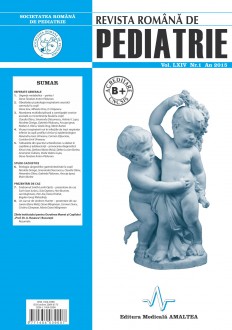SELECT ISSUE

Indexed

| |

|
|
|
| |
|
|
|

|
|
|
|
|
|
|
HIGHLIGHTS
National Awards “Science and Research”
NEW! RJP has announced the annually National Award for "Science and Research" for the best scientific articles published throughout the year in the official journal.
Read the Recommendations for the Conduct, Reporting, Editing, and Publication of Scholarly work in Medical Journals.
The published medical research literature is a global public good. Medical journal editors have a social responsibility to promote global health by publishing, whenever possible, research that furthers health worldwide.
ETIOLOGY OF GASTROINTESTINAL BLEEDING IN CHILDREN
Nicoleta Gimiga, Smaranda Diaconescu, Claudia Olaru, Alexandru Olaru, Gabriela Paduraru, Ancuta Ignat and Marin Burlea
ABSTRACT
Objectives. Identification of clinical, endoscopic, etiological characteristic of children diagnosed with upper and lower gastrointestinal bleeding.
Material and methods. It was conducted a descriptive retrospective study over a 3 year period (January 2010 to December 2012) on 107 children aged 1-18 years hospitalized for gastrointestinal bleeding in ”St. Mary” Children’s Emergency Hospital, Iasi. The study group does not include gastrointestinal bleeding from surgical emergencies, infectious diseases, intestinal diseases with immunological or toxic mechanism. Individualized retrospective analysis included historical data, clinical, endoscopic and histological targeted for etiologic diagnosis of gastrointestinal bleeding. All patients were investigated by upper gastrointestinal endoscopy/colonoscopy after the procedure was explained and informed consent was obtained.
Results. From the batch of 107 children, 39 (36.4%) presented with upper gastrointestinal bleeding (UGIB) 6 (5.1%) was variceal, non-variceal in 33 (94.4%) cases, and 68 (63.5%) presented with lower gastrointestinal bleeding (LGIB). The main etiologycal aspect of UGB was erosive gastritis 30.8%, oesophagitis in 15.4%, duodenitis in 15.4%, gastric and duodenal ulcers 5,1% and respectivily 10.3% of cases, Mallory-Weiss syndrome in 2.6%, multiple etiology in 10 cases 15.4%. Causes of LGIB were colorectal polyps in 41.2.%, ulcerative colitis 20.6%, non specific lessions in 17.6% anal fissures 13.2%, intestinal polyposis 4.4 %, rectal diverticula 1.5% and vascular malformations 1.5%. It was practiced concomitent endoscopic surgery for rectal polyps.
Conclusions. Lower gastrointestinal bleeding was the most common causes related to minor conditions: colorectal polyps, anal fissures, nonspecific lesions. Non-variceal gastrointestinal bleeding the most common form associated with erosive gastritis, esophagitis, duodenal ulcer, gastric ulcer. Endoscopy proved to be a useful investigation in the diagnosis of gastrointestinal bleeding and a therapeutic useful tool in certain cases.
Keywords: gastrointestinal bleeding, children, etiology, endoscopy, colonoscopy
